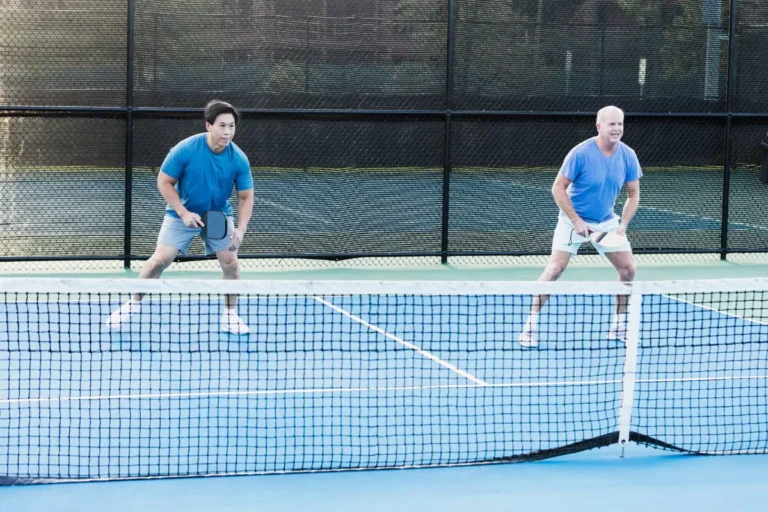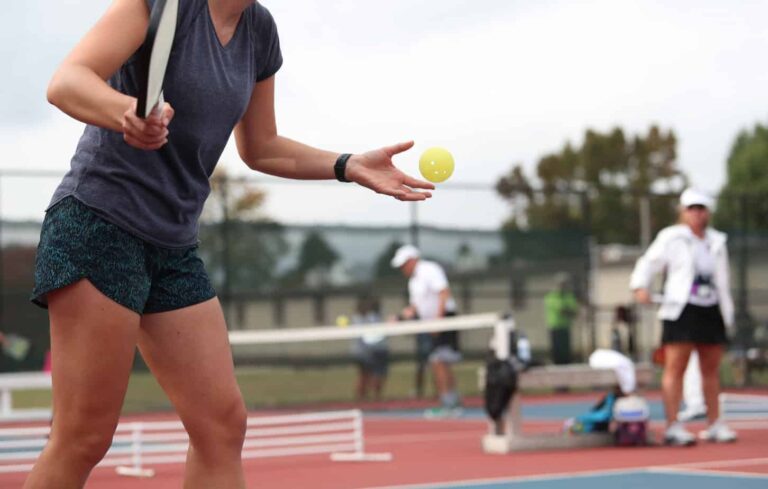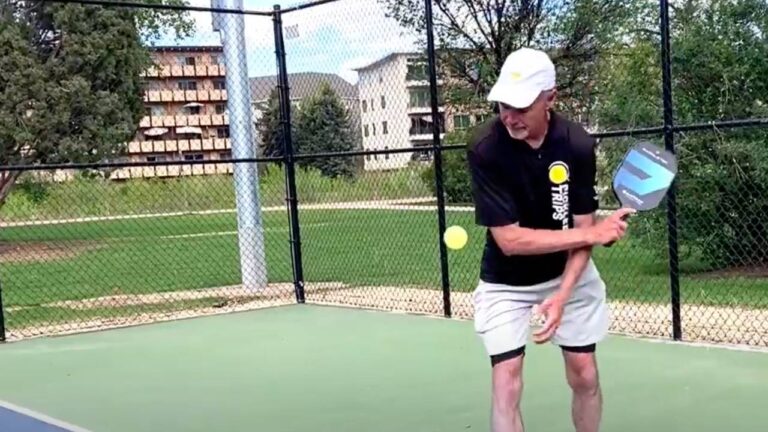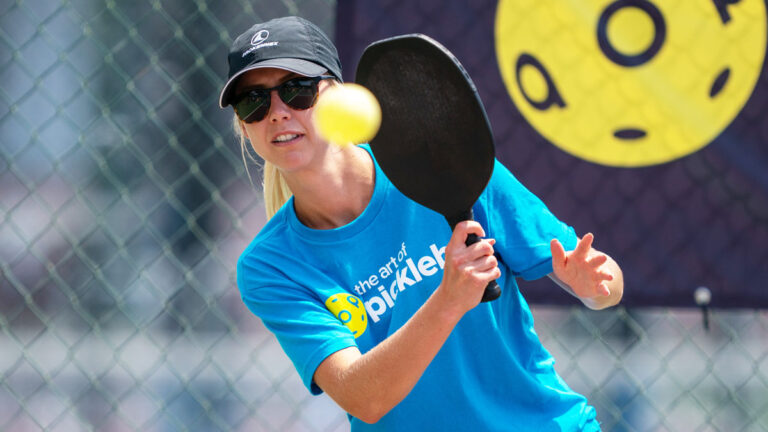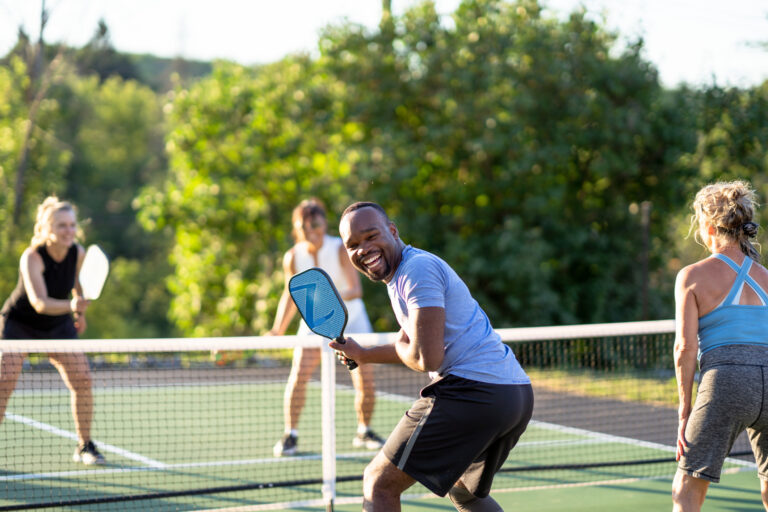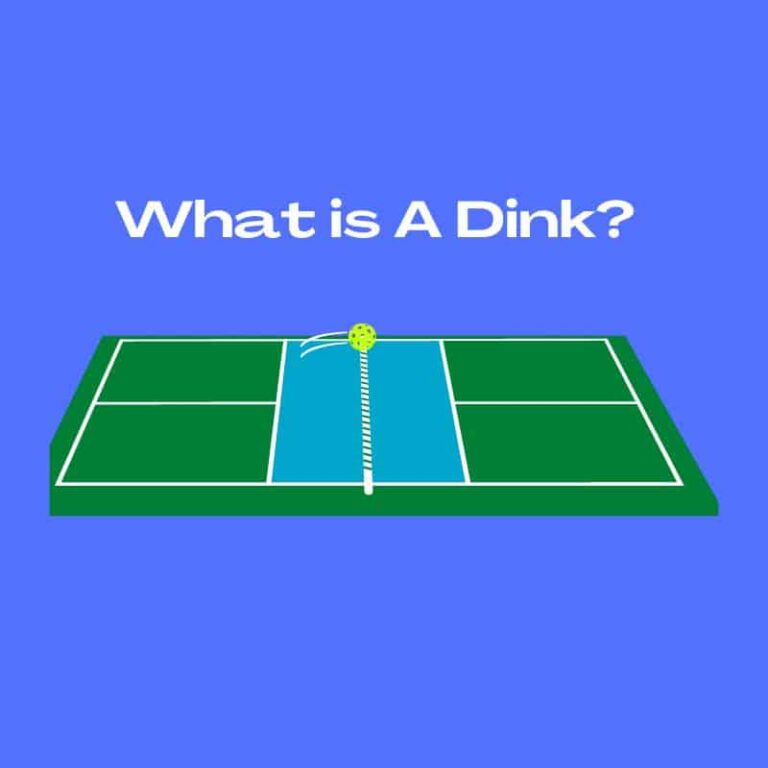Navigating Pickleball Serving Rules: A Player’s Manual
By Understanding Pickleball Serving Rules, you serve underhand, hitting the ball below your waist with your paddle’s head below your wrist. Make sure you’re standing firmly behind the baseline and aim diagonally across the court, clear from the non-volley zone. It’s a fault if you serve out of bounds or hit the net. Strategic serving involves mixing up serve placements, often targeting the middle and deep parts the court and exploiting any weaknesses in your opponent’s game. Becoming adept at these rules will increase your chances scoring points. Now that you know the basics, let’s explore more advanced strategies.
Main Points
- Serve must be executed underhand with paddle contact below the wrist and the ball hit below waist.
- The server must stand firmly behind the baseline with feet not touching the Non-Volley Zone.
- Serves should be directed over the net to the diagonally opposite service court.
- Common faults include serving out of bounds, hitting the net, foot faults, and incorrect paddle contact.
- It’s crucial to maintain consistency in serves and strategically place them to exploit opponents’ weaknesses.
Understanding Pickleball Serving Basics
To master pickleball, you need to understand serving basics, which involve executing an underhand serve hit below the navel, with your paddle head below the wrist and feet firmly planted behind the baseline. This unique serve technique, unlike other racket sports, follows an upward arc motion. It’s not just about the swing; the placement of your feet matters too. The rules necessitate that your feet must stay behind the baseline when serving. Failure to do so could result in a fault.
The journey of the ball after you serve is equally important. To have a legal serve in pickleball, it must travel over the net and land within the crosscourt service box. That’s not all; it also needs to avoid touching the Non-Volley Zone. This detailed precision makes serving in pickleball a skill to master, and violating these rules can lead to a fault, meaning a lost rally or serve.
Upholding these rules isn’t just about avoiding penalties or winning, but about maintaining the integrity of the game. Understanding and adhering to these serve rules ensure fair play and a smooth start to each pickleball rally. Remember, every good game begins with a good serve.
Key Rules for Pickleball Serving
As you serve in pickleball, remember it’s all about the underhand, the angle of your arm, and maintaining the right position.
You’re required to hit the ball below your waist and make sure your paddle makes contact below the wrist.
Keep in mind, standing behind the baseline while serving over the net into the correct court is essential.
Pickleball Serving Basics
Understanding the basics of pickleball serving is crucial, and it all starts with an underhand swing, below the waist, to kick off a point. Your arm should move in an upward arc at paddle contact, with the ball hitting below the wrist at the swing’s peak. This underhand serve not just follows the rules but also assists in control and accuracy.
The target? The service court diagonally opposite from where you’re serving. Aim for that spot and follow through your serve, maintaining an unwavering eye on your target. This follow-through keeps your accuracy intact and ensures the serve lands where intended.
Faults in Serving
While mastering pickleball serving basics is essential, it’s equally important to know common serving faults, which can cost you a point or even the serve. These faults include serving outside the boundaries or hitting the net. If you don’t hit the ball below the waist or if your foot steps on the baseline during the serve, these are also considered faults.
These faults typically result in a loss of serve or a side out, meaning the opposing team gets the serve. More damaging, foot faults, improper paddle contact with the ball, or serving from the incorrect service court can lead to direct points for the receiving team. So, it’s critical to understand and avoid these faults to maintain fair play.
Strategic Serving Tips
To step up your pickleball game, consider these strategic serving tips that can keep your opponents guessing and give your team the upper hand. A good serve can set the tone for the entire volley.
- Strategic Serving: The key lies in mixing up your serves. Vary your serve placement to keep your opponents off balance and guessing.
- Serve Placement: Aim for deep serves and central serves. This will force your opponent to stay back, giving you control over the point.
- Diagonal Serving: Try to serve diagonally opposite the service court. This can set up your team for a strong position.
- Consistency: Consistency in your serves will put pressure on your opponents and help maintain control throughout the game.
Common Pickleball Serving Faults
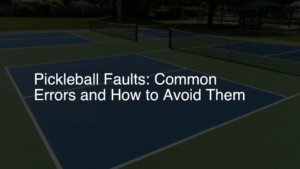
Exploring the world of pickleball, you’ll encounter several common serving faults, such as serving out of bounds, hitting the net, or even stepping on the non-volley zone during your serve. These faults can disrupt the flow of the game, so it’s important to understand and avoid them.
Another common fault occurs when you serve before the receiver is ready. You must make sure that your opponent is prepared before making your serve, as per the principles of fair play. Also, failing to make an underhand serve or serving above the waist is considered a fault in pickleball. The serve must always be executed with an underhand stroke, and the paddle must contact the ball below your waist level.
If your serve lands in the wrong service court, not diagonally opposite, it’s also a fault. You must aim to have the ball bounce in the correct court. More common faults include not allowing the ball to bounce before serving, stepping over the baseline during your serve, or completely missing the ball. Avoiding these common faults will help keep the game running smoothly.
Pickleball Serve Positioning Guide
After understanding the common serving faults in pickleball, let’s now focus on the importance regarding correct server positioning to guarantee a fair and accurate serve delivery.
- Start by positioning yourself as the server behind the baseline. This is a fundamental rule in pickleball serving. Remember, your feet should remain behind the baseline throughout the serve. Violating this can lead to faults and disrupt the flow of the game.
- Proper serve positioning doesn’t just guarantee accurate and fair serve delivery. It’s also essential to follow the rules of the game. Be aware of the sidelines and the center line as these boundaries play a key role in your serve positioning.
- The positioning of the server also dictates where the serve should land in the opponent’s court. This is important for an accurate and legal serve.
- Finally, correct serve positioning is the foundation of executing effective serves. It’s not just about power but positioning and accuracy as well.
Mastering Pickleball Serving Sequence
Understanding the serving sequence in pickleball can greatly enhance your game strategy, as it determines how both players on the serving doubles team get a chance to serve until a fault is committed. This serving sequence is integral to your court position, ensuring fair play and strategic positioning.
In doubles, the serving player starts from the right or even court. After scoring a point, you’ll switch sides, continuing this until a fault occurs. The serving team’s score determines your court position.
For singles, you’ll serve from the right court for even scores, and from the left for odd scores. This approach maintains the spirit that promotes fair play, while allowing strategic positioning for each pickleball serve.
Here’s a quick reference guide:
| Doubles/Singles | Even Score | Odd Score |
|---|---|---|
| Doubles | Right Court | Switch sides |
| Singles | Right Court | Left Court |
Mastering the serving sequence isn’t just about following rules, it’s about using them to your advantage to boost your pickleball game. Remember, the serving player often sets the tone the game, so make your serve count!
Winning Strategies for Pickleball Serves
You’re now ready to up your game with winning strategies for pickleball serves.
Let’s focus on perfecting your serve technique and developing a smart serve selection strategy.
Perfecting Your Serve Technique
To master the perfect serve in pickleball, start by refining your underhand serve technique, ensuring proper arm movement and paddle positioning below the wrist. This technique is essential and also adaptable for players with disabilities.
To keep your serves sharp and effective, follow these four steps:
- Aim for a diagonal placement from your service court to the opposite one, ensuring depth and centrality to keep opponents guessing.
- Introduce variations in your serve placement to maintain an element of surprise in your matches.
- Be sure your serve lands within the crosscourt service box but stays out the non-volley zone to avoid faults.
- Practice both traditional volley serves and drop serves to enhance your flexibility during games.
Smart Serve Selection Strategy
Mastering the art of strategic serve selection in pickleball can greatly enhance your competitive edge in matches. It’s essential to exploit your opponent’s weaknesses, varying your serve placement and speed to keep them off balance. Aim for serving deep and towards the middle of the court. This narrows their options and sets you up for advantageous plays.
Be adaptable and responsive. If you notice your opponent struggling with a particular serve speed or placement, use it to your advantage. By continually adjusting your serve strategies, you’ll keep your opponents guessing and increase your chances of gaining points and match victories.
Frequently Asked Questions
What Are the Rules for Serving in Pickleball?
In pickleball, you’ve to serve underhand, below the waist, and aim diagonally. You get one serve attempt and must stay behind the baseline till after the third shot. Following through in the direction of your target is key.
What Is an Illegal Serve in Pickleball?
In pickleball, you’re dealing with an illegal serve if you serve above the waist, hit the net, serve from the wrong court, or step over the baseline. Such mistakes can cost your team the serve.
Is It Legal to Bounce the Ball When Serving in Pickleball?
Yes, you’re allowed to bounce the ball before serving in pickleball. It’s a strategy some players use to control serve placement and speed. It’s totally legal and can help maintain consistency in your serves.
Can the Ball Hit the Net on a Serve in Pickleball?
Yes, you’re allowed to hit the net on your pickleball serve. If it then lands in the correct court, it’s called a ‘let’ and you can re-serve without penalty. If it’s out, it’s a fault.
Conclusion
So, you’ve got the rundown on pickleball serving rules. From the basics to common faults, positioning, sequence, and winning strategies, you’re all set to ace your serves.
Remember, practice makes perfect. Keep these key points in mind, take the time to refine your skills, and you’ll be serving up a storm in no time.
With your newfound knowledge, you’re ready to step onto the pickleball court and serve with confidence. Game on!

